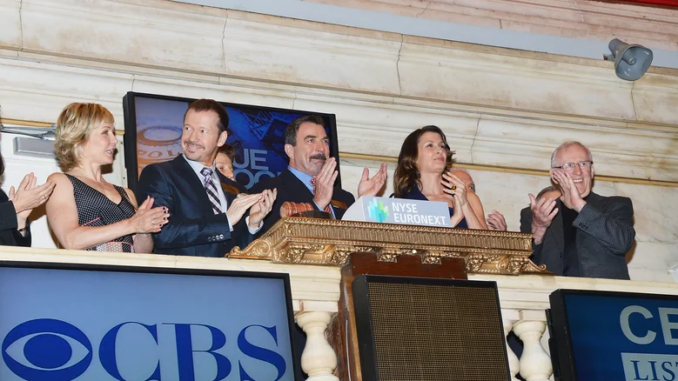
A ‘Blue Bloods’ Farewell: Why Saying Goodbye to the Reagans Is So Hard
We hate to see them go. Blue Bloods’ looming departure on CBS this December after 14 hit seasons will leave millions of faithful fans with not only a hole in their hearts but also in their Friday night TV schedule.
The seeds of the family-first cop drama were planted when The Sopranos writers Mitchell Burgess and Robin Green decided to deviate from the late-2000s trend of shows with dark antiheroes (Breaking Bad, Dexter). “We wanted to go for the positive, the heroic,” Green noted in 2010, when Blue Bloods premiered.
Joining with veteran network exec and producer Leonard Goldberg (Starsky & Hutch), they found their heroes in the fictional Reagans, a tight-knit, multigenerational Irish Catholic clan of NYPD cops and an assistant district attorney who investigate and prosecute crimes, rather than commit them. The police procedural planned to have action-packed, edge-of-your-seat moments but would really home in on the family drama and interwoven relationships.
Blue Bloods was an instant hit, winning a live premiere audience of 13 million and going on to dominate primetime Friday TV throughout its long run. Though Burgess and Green left after one season, and Goldberg died in 2019, showrunner Kevin Wade has ably kept Blue Bloods’ promise in mind all the way to the end.

There’s no doubt that casting Tom Selleck as NYC police commissioner and household head Frank Reagan has been a seminal part of the show’s success. The charismatic actor was already well-known in movies and television — for popular Western flicks, a stint on Friends, as a small-town police chief in the lauded Jesse Stone films and, of course, for his Emmy-winning role as CBS’s easygoing detective in Magnum, P.I. As commish, Frank can be stern and by-the-book, but his self-deprecating humor and a knack for usually making the right decision created an appealing, admirable lead.
The cocreators also hit gold with the rest of the Reagan clan: veteran Len Cariou as Frank’s opinionated “Pop,” retired PC Henry, with whom he lives in Brooklyn; Donnie Wahlberg as Frank’s older son, cocky detective Danny; Bridget Moynahan as his daughter, strong-willed prosecutor Erin; and Will Estes as younger son Jamie, an Ivy League law school grad turned cop who’s now a detective in the undercover intelligence unit.
Despite personal and professional storylines making good use of the actors and busy Big Apple streets, the show’s heart is in the family’s weekly Sunday dinner scenes. It was an idea Goldberg introduced in the pilot, inspired by Norman Rockwell’s 1943 Thanksgiving magazine illustration, titled Freedom From Want. Selleck recalls admiring the dining scene in that first script but was worried it would be cut down, if not cut out, by the network.
Hardly. Viewers found the weekly meals a sort of wish fulfillment. The family, including, in early seasons, Danny’s wife, hardworking nurse Linda (Amy Carlson), and later, Jamie’s eventual spouse, fellow cop Eddie Janko (Vanessa Ray), discussed and debated the legal and ethical choices they made on the job, evolving police tactics and adversarial mayors — all with Frank cracking a joke here and there to diffuse any tension between bites.
Loss was also felt around the table: Frank memorialized Linda, who died in a helicopter crash offscreen between Seasons 7 and 8 — and six years later, did the same for his former partner Lenny Ross (the late Treat Williams). There was joy too, like when Jamie announced his engagement to Eddie in the Season 8 finale, and in Season 10’s unexpected twist, when young NYPD detective Joe Hill (Will Hochman) movingly met his shocked relatives after learning that he was the son of eldest Reagan son Joe Sr., who died before the series began. (We quickly recognized a certain type of bravado DNA in Hochman’s Joe.)
But Blue Bloods’ enduring appeal lies in the Reagans’ likability and relatability. Viewers are invested in this unforgettable fictional family. They’re emotionally connected to the characters and earnestly root for them.
The tight-knit bond of the Reagans reflects what goes on behind the cameras too. In our many visits to CBS’s Brooklyn set, we saw firsthand what Wahlberg describes as “an incredible closeness” between the cast members. During scene breaks, you might see Wahlberg dancing with his costars, Ray giggling at Estes’ teasing or catching wry comments from Selleck, the set’s spiritual guide. It’s easy to get cranky with long hours of shooting while you poke at cold food, but spirits stay high, and respect for castmates — and crew — permeates the set. When the cameras turn back on, that warmth is what shows up on the screen. And as Blue Bloods finishes up its last meal, it’s a feeling that will be sorely missed by many.
